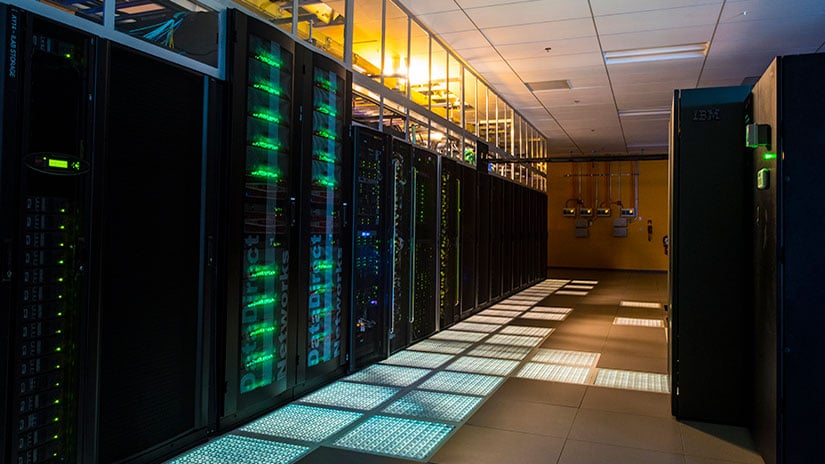High-Performance Computing and Data Visualization
NLR's High-Performance Computing (HPC) Data Center, supercomputing systems, and visualization capabilities propel technology innovation by tackling energy challenges that cannot be addressed through traditional experimentation alone.

NLR's HPC experts collaborate with scientists and engineers to take full advantage of advanced computing hardware and software resources that provide the computing scale and speed necessary to advance renewable energy and energy-efficiency technologies. Advanced visualization technology helps researchers explore and interact with data in new ways that accelerate understanding and innovation. Computational science is a key driver of energy systems integration research in the ESIF.
The Kestrel HPC system has expanded NLR's supercomputing capacity to 44 petaflops.
The ESIF offers these unique capabilities in HPC:
44-petaflop Hewlett Packard Enterprise Intel Sapphire Rapids CPUs and nVidia H100 GPUs
2,454 compute nodes
604 terabytes of total memory
95 petabytes of high-speed data storage
Innovative warm-water liquid-cooling system that allows waste heat to be captured for reuse in the ESIF
8.0-petaflop Hewlett Packard Enterprise SGI 8600 system with Intel Skylake processors
2,114 compute nodes, each with 96, 192, or 768 gigabytes of memory
296 terabytes of total memory
14 petabytes of high-speed data storage with read/write capabilities exceeding 250 GB/second
Mellanox EDR InfiniBand high-speed interconnection
Innovative warm-water liquid-cooling system that allows waste heat to be captured for reuse in the ESIF
SuperMicro Based Cluster supporting the Department of Energy Vehicles Technology Office with AMD 7532 Rome processors
440 compute nodes each with 256 gigabytes of memory
3PB of NFS-based file storage
On-site and remote viewing of experimental data, high-resolution visual imagery, and large-scale simulation data
Stereoscopic, immersive 3D visualization environment comprising six projectors that illuminate two surfaces—the wall and the floor—which can be used in conjunction with an optical tracker to bring scientific data to the human scale
A suite of virtual reality (VR) and augmented reality head-mounted displays
Large, multitouch 100-megapixel image display that delivers high-resolution 2D visual imagery, enabling researchers to analyze large-scale simulations, ensembles of simulations, and highly detailed visual analytics displays
Five-node, high-availability cluster built on a combination of open-source software to provide and manage data flows in and out of labs, allowing projects to stream their data out of lab equipment and integrate them with other devices or simulation systems, e.g., to enable hardware-in-the-loop experimentation
Interconnects data between on- or off-site devices, simulations, files, databases, analytical tools, scripts, remote data sources, or external partners
Enables streaming data to the high-performance computer, the Insight Center for real-time visualization, and the ESIF Research Data Repository for persistent archive of data
Share
Last Updated Dec. 4, 2025
